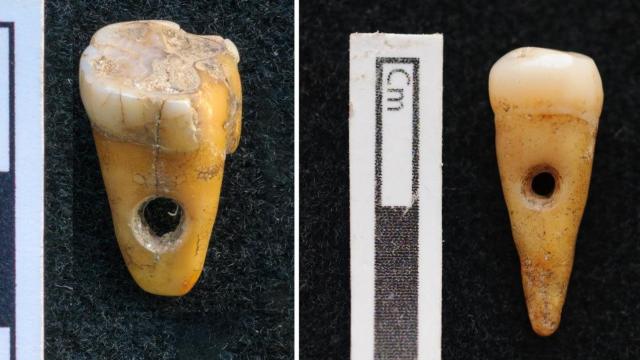Researchers in Turkey have uncovered modified Neolithic human teeth that were worn as pendants, perhaps in a necklace or bracelet, in a rare and perplexing archaeological find.
Paleolithic and Neolithic humans often fashioned jewellery, such as beads and pendants, from animal bones and teeth (fun fact: Neanderthals wore jewellery made from eagle talons). The use of human bones and teeth for such adornments is less common, but not without precedent, and it’s unclear what cultural, spiritual, and aesthetic concerns may have motivated the practice.
New research published in the Journal of Archaeological Science: Reports describes the discovery of two modified human teeth that were worn as jewellery some 8,500 years ago at Çatalhöyük, a site in the Central Anatolia region of Turkey. This practice, though rare, has previously been documented at European sites dating back to the Upper Paleolithic, Mesolithic, and Neolithic periods, but this is the first time the practice has been documented in the prehistoric Near East. The new study was led by Scott Haddow from the Department of Cross-Cultural and Regional Studies at the University of Copenhagen in Denmark.
The teeth were found within the larger of two mounds located at the Çatalhöyük archaeological site, an important Late Neolithic settlement. The 13 hectares site contains traces of mudbrick dwellings, animal enclosures, garbage piles, and other remnants of daily human life. Since 1993, archaeologists have uncovered nearly 700 burials at Çatalhöyük, some of which contained grave goods such as beads and pendants made from animal bones and teeth. Importantly, neither of the two modified human teeth, which were discovered during excavations made between 2013 to 2015, were found in a burial setting.
The 8,500-year-old teeth—both molars—were manually modified to be used as pendants in a necklace or bracelet (a third tooth, also a molar, was also found, but the scientists couldn’t definitively prove that it was modified and worn as jewellery). Holes in the roots of the teeth were made with a cone-shaped “microdrill” made from flint or obsidian, a tool that was likely used to drill holes in the animal bones and teeth found at the site. The quality of the holes suggest they were drilled by a skilled and experienced individual.
Visual analysis of the modified teeth, along with microscopic analysis and x-ray scans, revealed “microwear” traces on the teeth consistent with their extensive use as jewellery, including glass-like smoothness. The teeth were extracted from two deceased adults who were between the ages of 30 and 50 when they died. Neither of the teeth showed signs of disease or decay, so it’s highly unlikely the teeth fell out prior to death.
So why did some Neolithic Turks wear human teeth as jewellery?
Given the rarity of the find, it’s clear this wasn’t a hugely popular practice. Accordingly, the researchers believe it’s “very unlikely that these modified human teeth were used solely for aesthetic purposes,” and that instead, the human teeth “carried profound symbolic meaning for the people who wore them,” explained Haddow in a press release.
Indeed, the practice is potentially reminiscent of Papuan bone daggers made from human femurs, which carried tremendous prestige for the owner.
[referenced url=” thumb=” title=” excerpt=”]
That said, none of the graves at Çatalhöyük were found to contain modified human teeth, which suggests these items were not associated with burials. It’s not immediately obvious as to why this is the case. The human teeth pendants might be related to specific and rare ritual taboos, or possibly something having to do with “the two individuals from whom the teeth were extracted,” said Haddow.
“However, given the small sample size, the ultimate meaning of the human teeth pendants will remain elusive until new findings at Çatalhöyük or elsewhere in the Near East can help us better contextualise the meaning these human teeth artefacts,” added Haddow.
Until more evidence is found, we’ll have to be content with these sorts of speculations. It’s clear, however, that the wearing of human teeth is a profound statement, regardless of the exact message.
